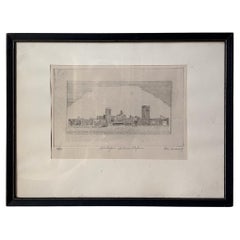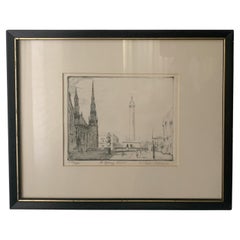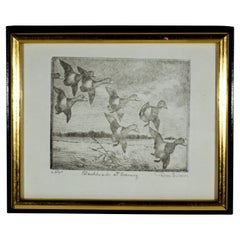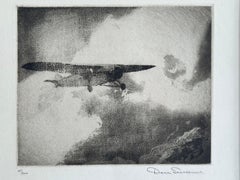Don Swann Etching
1950 Original Etching by Don Swann, Jr.
Located in Saint Petersburg, FL
Framed etching by Don Swann Jr of Baltimore Skyline. Etched onto Cooper plates before printing
Category
20th Century American Post-Modern Drawings
Materials
Copper
Don Swann (1889-1954) Original Etching Limited Editon
Located in Saint Petersburg, FL
Limited edition original etching by American artist Don Swann (1889-1954). Titled a "A Spring
Category
Mid-20th Century American American Classical Drawings
Materials
Copper
Don Swann Original Etching Blackheads at Evening 53/300, Framed
Located in Clifton Springs, NY
side, please refer to pictures. The etching is in very good vintage condition.
Don Swann (1889-1954
Category
20th Century American Mid-Century Modern Drawings
Materials
Paper, Wood
$260 Sale Price
20% Off
H 7.5 in W 9 in D 1.15 in
Single engine monoplane in flight
Located in Wilton Manors, FL
Don Swann (1899-1954). Monoplane in flight. Etching, plate measures6 x 7.25 inches. Edition of 300
Category
1930s American Impressionist More Prints
Materials
Etching
Johns Hopkins Hospital
By Samuel Donovan Swann
Located in San Francisco, CA
This artwork is an etching on wove paper by Samuel Donovan aka Don Swann (American, 1889-1954
Category
Mid-20th Century Realist Landscape Prints
Materials
Etching
Johns Hopkins Hospital
By Samuel Donovan Swann
Located in San Francisco, CA
This artwork is an etching on wove paper by Samuel Donovan aka Don Swann (American, 1889-1954
Category
Mid-20th Century Realist Landscape Prints
Materials
Etching
Recent Sales
Single engine monoplane in flight
Located in Wilton Manors, FL
Don Swann (1899-1954). Monoplane in flight. Etching, plate measures6 x 7.25 inches. Edition of 300
Category
1930s American Impressionist More Prints
Materials
Etching
People Also Browsed
Vintage (1978) Pencil Sketch Art of Cat, 11 X 14 Framed , signed
Located in Saint Petersburg, FL
Original midcentury sketch art, signed by artist.
Category
Vintage 1970s Unknown Mid-Century Modern Drawings
Materials
Silver
Factory, Original oil Painting, Ready to Hang
By Vahe Yeremyan
Located in Granada Hills, CA
Artist: Vahe Yeremyan
Work: Original Oil Painting, Handmade Artwork, One of a Kind
Medium: Oil on Canvas
Year: 2022
Style: Impressionism,
Subject: Factory,
Size: 13" x 9.5" x 0.8...
Category
2010s Impressionist Landscape Paintings
Materials
Oil, Canvas
Rare Wave-Pattern Upholstery, Swivel Lounge Chair, Manner of Milo Baughman
By Milo Baughman
Located in Saint Petersburg, FL
Wave-pattern upholstery highlights a curvaceous & sculptural form. Wood pedestal base, with a 360 degree swivel mechanism. Chair maintains it's good structure. Extremely comfortable!
Category
20th Century American Mid-Century Modern Club Chairs
Materials
Velvet, Wood
$3,150
H 31.5 in W 33 in D 32 in
Rare Solid Bronze Armorial Crest Coat of Arms Lovely Verdigris Patination
Located in West Sussex, Pulborough
We are delighted to offer for sale this lovely antique solid bronze coat of arms armorial crest with lovely natural verdigris patina
This is a very good looking and well made coa...
Category
20th Century English Post-Modern Arms, Armor and Weapons
Materials
Bronze
$3,689
H 11.03 in W 7.88 in D 1.97 in
Vintage Century Chinoiserie Style Chin Hua Console Table
By Century Furniture
Located in Swedesboro, NJ
Dimensions - H: 31 1/4 in W: 73 in D: 18 in
Introduce timeless sophistication to your interior with this striking Vintage Chinoiserie Style Console Table from the iconic Chin Hua C...
Category
Late 20th Century Unknown Chinoiserie Console Tables
Materials
Brass
Clay Female Portrait Bust Sculpture
Located in Saint Petersburg, FL
Emotive FRENCH Neoclassical Bust. Intentional unfinished appearance; unglazed rough texture, emphasizes the beauty and imperfection of natural forms.
Category
Antique 19th Century French Neoclassical Figurative Sculptures
Materials
Clay, Terracotta
Antique English Regency Fire Mantel
Located in Wormelow, Herefordshire
An antique late Georgian or Regency period painted pine and gesso/composition fire surround. Dating to circa 1820, this stunning fireplace is an original of the English Georgian and ...
Category
Antique Early 19th Century English Georgian Fireplaces and Mantels
Materials
Composition
19th Century French Louis XVI Gilded Wood Trumeau Glass Mirror - Antique Décor
Located in West Palm Beach, FL
A 19th Century French antique mirror patinated in a grey-bleu finish. Partial giltwood and original mirrored glass, in good condition. The top of the Louis XVI trumeau mirror frame i...
Category
Antique Mid-19th Century French Louis XVI Wall Mirrors
Materials
Mirror, Giltwood
$7,800
H 68.5 in W 48.5 in D 3 in
Rare 19th c. Antique Terracotta Water Urn with Iron Spout, Whitewashed Patina
Located in Saint Petersburg, FL
Antique 19th century water urn with faucet. Urn is a testament to the history and artistry of a bygone era. Made from terracotta material, displays decorative motifs, featuring a uni...
Category
Antique 19th Century Moroccan Spanish Colonial Urns
Materials
Iron
Waterford Crystal Ships Decanter and Stopper Alana
By Waterford Crystal
Located in Clifton Springs, NY
Vintage cut crystal ships decanter with stopper was made by Waterford in Alana pattern. The pattern was manufactured from 1952 to 2022; it is characterized by cut cross hatch with m...
Category
Late 20th Century Irish Mid-Century Modern Crystal Serveware
Materials
Crystal
The Cube Stool in Patch Umber by Sister By Studio Ashby
Located in London, GB
The Cube Stool, is the perfect foot perch or pair it with a brass tray and cocktail glasses for a chic and stylish aperitif hour.
Kilims are a staple at Sister for their hard-wear...
Category
2010s European Footstools
Materials
Fabric
$1,141 / item
H 17.33 in W 17.33 in D 17.33 in
Circa 1900 English Brass Fireplace Fan
Located in Chapel Hill, NC
Circa 1900 brass fireplace fan, English. Cast & cut-work brass; bold acanthus finial. Used to screen the opening in warmer months. Edwardian period. 38.5" wide open, 7.5" closed. 28"...
Category
Antique Early 1900s English Edwardian Fireplace Tools and Chimney Pots
Materials
Brass
Wicker Ottoman Upholstered Seat
Located in New York, NY
A round wicker ottoman with an orange-burnt orange upholstered seat cushion and blackened iron base. Ottoman or stool has a black iron base with four legs, tan wicker exterior around...
Category
2010s American Ottomans and Poufs
Materials
Iron
"Study of a Goat's Head" Frans Lebret (Dutch, 1820-1909)
Located in SANTA FE, NM
"Study of a Goat"
Frans Lebret (Netherlands, 1820-1909)
Oil on paper on wood panel
9 x 10 (13 1/2 x 14 1/4 frame) inches
Initialled lower right
This is a simply stunning and deeply ...
Category
1870s Realist Animal Paintings
Materials
Paper, Oil, Wood Panel
Venini Fazzoletto Large Vase in Milk White by Fulvio Bianconi & Paolo Venini
By Fulvio Bianconi & Paolo Venini, Venini
Located in Brooklyn, NY
Fazzoletto glass vase, designed by Fulvio Bianconi and Paolo Venini and manufactured by Venini, is available in three different sizes. Original designed in 1948. Indoor use only.
...
Category
21st Century and Contemporary Italian Modern Vases
Materials
Glass
$1,617 / item
H 12.21 in Dm 9.06 in
1950s Norwegian Teak Sitting Bear Figure Sculpture Midcentury in Tjomsland Style
By Arne Tjomsland
Located in Hyattsville, MD
A vintage 1950s solid hand carved teak sitting bear cub figure. Burnished markings; Genuine teak, made in Norway. Designer is unknown, but in the manner of Arne Tjomsland, and from t...
Category
Vintage 1950s Norwegian Mid-Century Modern Animal Sculptures
Materials
Teak
$1,396 Sale Price
30% Off
H 4 in W 2.5 in D 4.75 in
Get Updated with New Arrivals
Save "Don Swann Etching", and we’ll notify you when there are new listings in this category.
Questions About Don Swann Etching
- What is etching?1 Answer1stDibs ExpertSeptember 25, 2019
Etching is a method of making prints using metal plates onto which a design has been incised by acid.
- What is a Picasso etching?1 Answer1stDibs ExpertApril 5, 2022An etching is created by cutting down a metal plate with chemicals, including acid, to achieve the desired image. The metal plate is then inked and pressed onto a piece of paper. Picasso became fascinated with etchings when he moved to Paris in the early 1900s, and would go on to pioneer new techniques with etchings throughout his career. Shop a selection of Pablo Picasso pieces from some of the world’s top art dealers on 1stDibs.
- What are the types of etching?1 Answer1stDibs ExpertSeptember 25, 2019
There is dry and wet etching.
- How do you identify an etching?1 Answer1stDibs ExpertNovember 26, 2024To identify an etching, look in the corners and on the back for an artist's signature or publisher information. Cross-referencing markings with information shared on trusted online resources can allow you to determine the artist. From there, you can browse online and print catalogues of their work to find out the title and date of the etching. In terms of how to tell an etching apart from other types of prints, one telltale sign is the appearance of slightly blurry lines along the edges. Called plate marks, these lines form from the pressure exerted by the plate during the etching process. You may need a magnifying glass to spot the plate mark on a print. If you have any difficulty with the identification process, consider enlisting the help of a certified appraiser or experienced art dealer. Shop a collection of etchings on 1stDibs.
- What is etched glass?1 Answer1stDibs ExpertFebruary 22, 2021Etched glass is a type of decorative glass which is the result of small cuts made to the glass. The cuts, which appear white, typically form patterns or images.
- What is vintage etching?1 Answer1stDibs ExpertApril 5, 2022Vintage etching is a term that refers to a specific type of print produced between 50 and 100 years ago. Printmakers produced etchings by carving images into a copper plate and then soaking it in an acid bath. Then, they applied ink to the plate and pressed it against paper or another material to create an image. On 1stDibs, find a collection of vintage etchings.
- What is an original etching?1 Answer1stDibs ExpertMarch 13, 2024An original etching is a print produced during the first production run of a print series. After making an etching plate, an artist will create a limited number of etchings. Collectively, these prints are the original etchings. They differ from restrike etchings made years later, sometimes after the death of the artist. On 1stDibs, shop a diverse assortment of etchings.
- Did Picasso make etchings?1 Answer1stDibs ExpertApril 5, 2022Yes, Pablo Picasso made etchings and took that foundation into an exploration of printmaking and the different methods of that medium. Picasso first began working on etchings in the early 1900s, quickly mastering the technique, and then he began expanding and pushing the boundaries to create a unique and signature style. On 1stDibs, find a variety of original artwork from top artists.
- Can I etch the back of a mirror?1 Answer1stDibs ExpertApril 5, 2022Yes, you can etch on the back of a mirror. Modern mirrors typically have a reflective layer that is deposited on the back of the glass. If you want to etch the back of a mirror you need to remove the reflective layer, which can be done with an engraving tool or with an etching solution. Shop a range of antique and modern mirrors on 1stDibs.
- 1stDibs ExpertAugust 26, 2024The difference between an etching and a print depends on how specific the terms are. Print is a general term for any type of artwork made by transferring an image onto another material, such as paper or fabric. A specific printmaking technique, etching is a way of incising lines in a metal plate by first drawing on an acid-resistant coating, or ground, to reveal the metal beneath. The plate is then submerged in acid, which “bites” the lines into the metal plate. On 1stDibs, find a large selection of etchings and other prints.
- 1stDibs ExpertOctober 15, 2024To tell if an etching is valuable, one approach is to conduct research using trusted online resources. The maker, age, image quality, historical significance and overall condition all play a role in determining the potential value of an etching. By seeing how much similar etchings have sold for in the past, you can get a rough idea of how much your piece may be worth. However, experts generally recommend having a certified appraiser or experienced art dealer evaluate prints for a more accurate valuation. Find a wide range of etchings on 1stDibs.
- 1stDibs ExpertOctober 24, 2024To tell a lithograph from an etching, look closely along the edges of the print. Etching is a way of incising lines on a metal plate by first drawing on an acid-resistant coating, or ground, to reveal the metal beneath. Lithography uses a stone rather than a plate. As a result, etchings will usually have a faint imprint or indentation called a plate mark, while a lithograph will not. Researching the artist using trusted online resources may also be helpful, as some printmakers worked exclusively with etchings or lithographs. Find a large selection of lithographs and etchings on 1stDibs.
- 1stDibs ExpertAugust 26, 2024The difference between etching and aquatint is technique. Invented in the 1500s, etching is a way of incising lines in a metal plate by first drawing on an acid-resistant coating, or ground, to reveal the metal beneath. The plate is then submerged in acid, which “bites” the lines into the metal plate. The ground is then removed, and the plate is inked for pressing. Etched lines tend to reveal the movement of the artist’s hand more than a technique like engraving, since the image is created on softer ground. Aquatint, a technique named for its resemblance to watercolor or ink wash, is often combined with etching to create rich tonal variations. It’s a similar process to etching, but the resin ground is more granulated, so the acid handles the metal differently. Different degrees of darkness are created based on the amount of time the plate is in contact with the acid. Find a collection of etchings and aquatint prints on 1stDibs.
- 1stDibs ExpertApril 3, 2024The difference between a lithograph and an etching is that while both are types of prints, they are made using different techniques. With respect to lithography, the image to be printed is drawn or painted on a stone or metal plate with an oil-based substance, such as a greasy crayon or tusche (an oily wash). The stone is then covered with water, which is repelled by the oily areas. Oil-based ink is then applied to the wet stone, adhering only to the oily image. Afterward, the stone is covered with a sheet of paper and run through a press.
Etching is a way of incising lines in a metal plate by first drawing on an acid-resistant coating, or ground, to reveal the metal beneath. The plate is then submerged in acid, which “bites” the lines into the metal plate. The ground is then removed and the plate is inked for pressing.
Find a collection of lithographs for sale on 1stDibs. - 1stDibs ExpertMarch 22, 2022Rembrandt's etchings are important because of the influence they had on printmaking. The printing techniques that he employed allowed each of his prints to seem very unique while making it possible for him to mass produce his images. Printmakers that followed utilized the advancements he made in the field to create and distribute their own prints. Find a range of Rembrandt art on 1stDibs.
- 1stDibs ExpertAugust 29, 2024To tell if an etching is original, first gently run your hand along its surface. An original etching will usually have a slight indentation in the image area left behind by the pressure applied by the plate during the printing process. Next, grab a magnifying glass and view the image up close. On an original, you won't see small dots making up the picture, but many reproductions do display dots due to their printing methods. Finally, look at the signature. Most original etchings will be hand-signed. If the signature is printed on your piece, it may be a reproduction. Consult a certified appraiser or experienced art dealer for an expert opinion on your print. Find a wide variety of etchings on 1stDibs.
- 1stDibs ExpertOctober 30, 2024Yes, some original etchings are worth something. Original signed prints by Old Masters like Rembrandt and Albrecht Dürer are particularly valuable, as are those made by modern artists such as Paul Klee, Henri Matisse, Martin Lewis and David Hockney. Generally, the artist, age, historical significance, image quality and overall conditions of etchings all contribute to their value. To learn how much your etching may be worth, seek the opinion of a certified appraiser or experienced art dealer. Explore a large collection of etchings on 1stDibs.
More Ways To Browse
Glass Leopard Sculpture
Glug Glug Decanter
Gluon Chair
Godot Bed
Gold And Mirror Armoire
Gold Glass Cocktail Pitcher
Gold Rimmed Goblets
Gold Scallop Shell Antique
Gold Tree Trunk
Golfer Statue
Golfers At Blackheath
Gope Board
Gorgone Antonio
Gorham Ladle
Gorham Lansdowne
Gorham Metalic Flower
Gorham Napkin Rings
Gorham Salt Pepper




